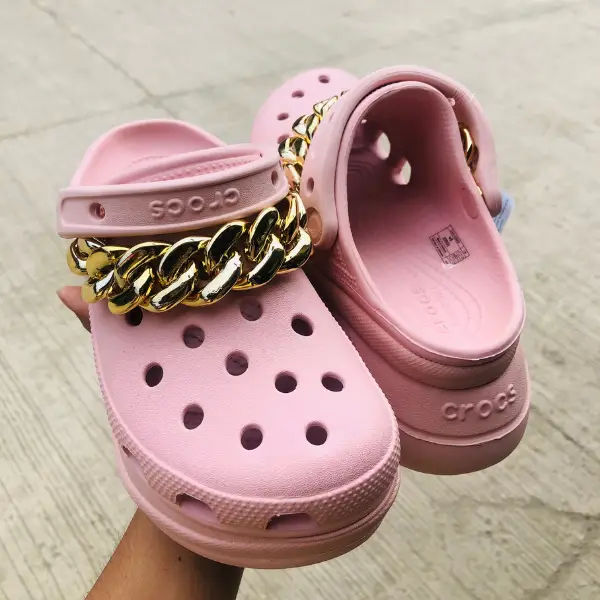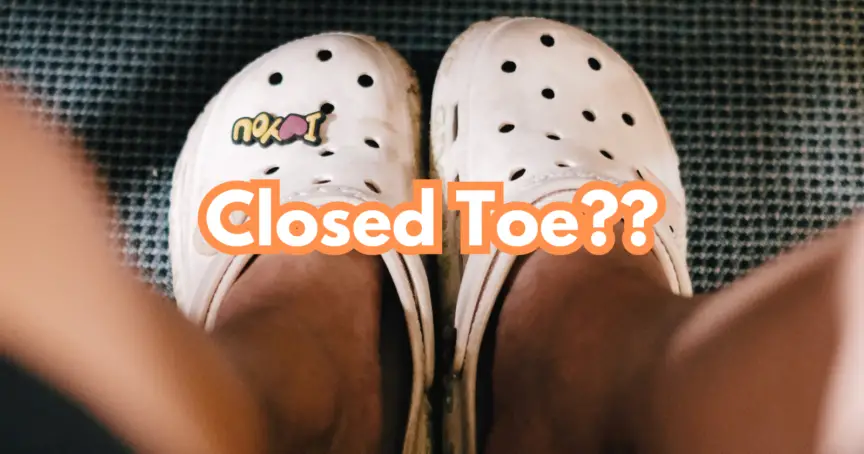ShoesandFitness.com is supported by our readers. We may earn a commission when you purchase through links on this page. Our content is checked for factual accuracy by our editorial team before being published.
If you’ve ever walked into a shoe store or scrolled through an online shopping site, chances are you’ve come across the wildly popular and often controversial footwear known as Crocs. With their unique design and vibrant colors, Crocs have generated a seemingly endless debate among footwear enthusiasts and fashionistas alike: are Crocs closed-toe shoes? In this article, I’ll delve into the history of Crocs, the definition of closed-toe shoes, and examine the arguments for and against classifying Crocs as such.
Are Crocs Closed Toe Shoes?
While Crocs are undoubtedly a comfortable and popular choice for footwear, they do not meet the requirements of closed toe shoes from a formal health and safety standpoint. The classic design of Crocs features 13 holes on the top, leaving the foot exposed and unprotected.
In contrast, closed toe shoes are expected to fully cover the foot, providing an extra layer of protection against potential hazards. So, if you are planning to engage in activities that require closed toe shoes, it’s best to opt for an alternative that fully covers your feet. Keep in mind that your safety should always be a top priority, and wearing appropriate footwear is a simple yet effective way to minimize risks.
Rock Your Crocs and Socks – Style Guide
Easy Methods to Make Crocs Bigger
Can You Wash Crocs with Fur in the Washing Machine
The Crocs Phenomenon
Crocs, the quirky footwear brand that has taken the world by storm, was first introduced in 2002. The brainchild of Lyndon “Duke” Hanson, Scott Seamans, and George Boedecker Jr., Crocs were initially developed as a comfortable and slip-resistant shoe for boating enthusiasts. However, the unique design and unparalleled comfort quickly captured the attention of consumers worldwide, catapulting Crocs into the mainstream.
As sales skyrocketed, Crocs expanded their product line to include a variety of styles, colors, and even collaborations with celebrities and designers. But with this meteoric rise in popularity came a wave of polarizing opinions. Some people praised Crocs for their functionality and comfort, while others criticized the shoes as an affront to fashion.
The controversy surrounding Crocs has only fueled their popularity, turning them into a cultural phenomenon. Today, Crocs are not only a staple in the wardrobes of millions but have also become a symbol of individuality and self-expression.
The Closed-Toe Shoe Definition
To better understand the ongoing debate, it’s important to first define what constitutes a closed-toe shoe. Closed-toe shoes are footwear that covers the entire foot, including the toes, with a solid material. This design provides protection and support for the foot, making it a popular choice for work and formal settings.
Examples of traditional closed-toe shoes include sneakers, loafers, oxfords, and pumps. These shoes are often required by dress codes in professional environments, schools, and other settings where open-toe footwear may be deemed inappropriate or unsafe.
The distinction between closed-toe and open-toe shoes is crucial, as it can impact factors such as safety, dress code compliance, and even personal style preferences.
The Case for Crocs as Closed-Toe Shoes
There are several design elements of Crocs that support the classification of these shoes as closed-toe. First and foremost, the signature Croslite material covers the entire foot, including the toes. This provides a level of protection similar to other closed-toe shoes, like sneakers or boots.
Additionally, Crocs share several features with traditional closed-toe shoes, such as a solid sole, a structured shape, and a secure fit. These similarities make it easy to draw comparisons between Crocs and other closed-toe options.
Proponents of classifying Crocs as closed-toe shoes often highlight the benefits of this designation. For instance, the closed-toe nature of Crocs provides extra protection for the feet, making them a viable option for individuals working in industries that require protective footwear. Furthermore, Crocs offer unparalleled comfort and breathability, making them an attractive choice for consumers who prioritize these qualities in their footwear.
The Case Against Crocs as Closed-Toe Shoes
Despite the aforementioned similarities between Crocs and traditional closed-toe shoes, there are design elements that challenge this classification. One notable difference is the presence of ventilation holes in the toe box of Crocs. These holes, while providing increased breathability, expose the toes to the elements and potential hazards, which is not characteristic of typical closed-toe shoes.
Additionally, the flexible nature of Crocs and their open heel design can lead some to argue that they more closely resemble open-toe shoes or hybrid footwear, like sandals or clogs. This distinction can be important, as open-toe shoes often do not provide the same level of protection or support as closed-toe options.
Critics of classifying Crocs as closed-toe shoes may point to the disadvantages of this designation. For example, the open design of Crocs may not be suitable for certain work environments, such as construction sites or industrial settings, where more robust protection is required. Moreover, the casual appearance of Crocs may not meet the dress code requirements of some professional or formal settings.

Workplace and School Policies
The debate surrounding the classification of Crocs as closed-toe shoes has real-world implications, particularly when it comes to workplace and school policies. Some organizations, such as hospitals and restaurants, may classify Crocs as closed-toe shoes due to their protective qualities and slip-resistant soles. These establishments often require closed-toe footwear for safety reasons and may permit the use of Crocs as a comfortable and practical alternative.
Conversely, other organizations, such as schools or corporate offices, may classify Crocs as open-toe shoes or deem them inappropriate for dress code purposes. These policies often hinge on the perception of Crocs as casual or unprofessional attire, as well as concerns about the ventilation holes and exposed toes.
Consumer Perspectives
Public opinions on the closed-toe shoe debate are as varied as the shoes themselves. Some consumers adamantly believe that Crocs should be considered closed-toe shoes, valuing their comfort and protection above all else. For these individuals, the classification of Crocs as closed-toe shoes may influence their purchasing decisions, as they seek out footwear that meets their specific needs and preferences.
On the other hand, some consumers argue that they do not meet the traditional definition of closed-toe shoes, instead considering them to be more akin to sandals or clogs. For these individuals, the classification of Crocs may not carry as much weight in their purchasing decisions, as they prioritize other factors such as style, functionality, or brand reputation.
Ultimately, personal preferences and style choices play a significant role in shaping consumer perspectives on the closed-toe shoe debate.
Conclusion
In conclusion, the debate over whether Crocs are closed-toe shoes is a multifaceted one, with valid arguments on both sides. While Crocs share some design elements with traditional closed-toe shoes, the presence of ventilation holes and the open heel design can also make them resemble open-toe shoes or hybrid footwear.
The classification of them as closed-toe or open-toe shoes has implications for workplace and school policies, as well as consumer purchasing decisions. Ultimately, it’s crucial for individuals to prioritize their own comfort and preferences when making footwear choices, rather than solely relying on labels and classifications.
As the Crocs phenomenon continues to evolve and spark conversation, it’s evident that the debate over their classification as closed-toe shoes won’t be going away anytime soon. But in the end, the most important factor is finding the right shoe for your unique needs, style, and comfort.




